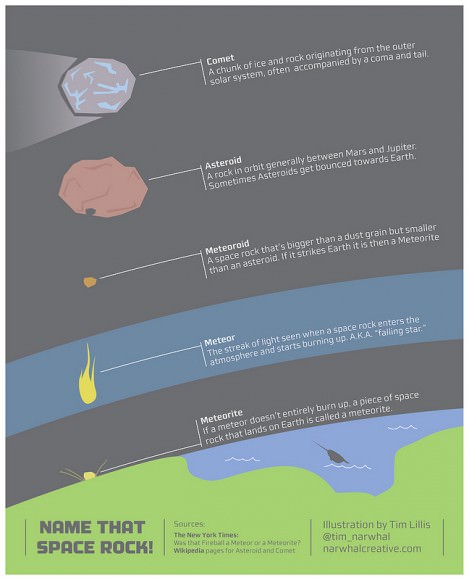Post by 1dave on Jan 9, 2018 11:01:37 GMT -5
The size of what classifies as an asteroid is not extremely well defined, as an asteroid can range from a few meters wide – like a boulder—to objects that are hundreds of kilometers in diameter. The largest asteroid is asteroid Ceres at about 952 km (592 miles) in diameter, and Ceres is so large that it is also categorized as a dwarf planet.
Read more at: phys.org/news/2015-06-difference-asteroids-meteorites.html#jCp
Read more at: phys.org/news/2015-06-difference-asteroids-meteorites.html#jCp

"Science" should use well defined terms, but it hasn't here.
I was just studying Wolf Creek Crater in Australia that is touted to be the "second largest METEOR impact crater on earth" - Barringer Crater in Arizona being the largest.

Note the areas blown clear by the shock waves that accompanied the meteor!
Wolf Creek:
The hole that it gouged out of the Devonian age quartzite rocks varies in diameter from 950 to 870 metres. The only bigger crater undoubtedly made by a meteorite impact is the Meteor Crater in Arizona.
Travelling at cosmic velocity, about 15km per second (that’s 40 times faster than a bullet from a high-powered rifle, or like crossing Australia in less than five minutes), the massive chunk of iron would have exploded on impact with the earth. Most of the meteorite, which was probably getting on for 100,000 tonnes in weight, would have been vapourised, along with huge quantities of the quartzite rock into which it ploughed.
Very little of the meteorite remains today, but sufficient has been collected for us to be sure that this was what made the crater. Like all iron meteorites, this one contained small quantities of nickel. In the weathered shale balls this nickel has been incorporated into what turned out to be a nickel-iron carbonate mineral not found anywhere else and which was new to science. This was named “reevesite” after Frank Reeves.
Travelling at cosmic velocity, about 15km per second (that’s 40 times faster than a bullet from a high-powered rifle, or like crossing Australia in less than five minutes), the massive chunk of iron would have exploded on impact with the earth. Most of the meteorite, which was probably getting on for 100,000 tonnes in weight, would have been vapourised, along with huge quantities of the quartzite rock into which it ploughed.
Very little of the meteorite remains today, but sufficient has been collected for us to be sure that this was what made the crater. Like all iron meteorites, this one contained small quantities of nickel. In the weathered shale balls this nickel has been incorporated into what turned out to be a nickel-iron carbonate mineral not found anywhere else and which was new to science. This was named “reevesite” after Frank Reeves.

Barringer:
The Meteorite
The meteorite weighed 300,000 tons and traveled at a speed of 26,000 miles per hour (12 kilometers per second). When it struck the earth in what is now northern Arizona, it exploded with the force of 2 ½ million tons of TNT, or about 150 times the force of the atomic bomb that destroyed Hiroshima. Most of the meteorite was melted by the force of the impact, and spread across the landscape in a very fine, nearly atomized mist of molten metal. Millions of tons of limestone and sandstone were blasted out of the crater, covering the ground for a mile in every direction with a blanket of shattered, pulverized and partially melted rock mixed with fragments of meteoritic iron.
The meteorite weighed 300,000 tons and traveled at a speed of 26,000 miles per hour (12 kilometers per second). When it struck the earth in what is now northern Arizona, it exploded with the force of 2 ½ million tons of TNT, or about 150 times the force of the atomic bomb that destroyed Hiroshima. Most of the meteorite was melted by the force of the impact, and spread across the landscape in a very fine, nearly atomized mist of molten metal. Millions of tons of limestone and sandstone were blasted out of the crater, covering the ground for a mile in every direction with a blanket of shattered, pulverized and partially melted rock mixed with fragments of meteoritic iron.
To my mind, 300,000 tons - about 50 meters (164 feet) in diameter - is a BIG boulder!
Still a meteoroid, not an asteroid. Hmm.
let's start at the beginning.
1. The supernovas.

2. Gravitational forces gather the material spewed out into cometary knots.
They are generally larger than the size of the Solar system (i.e. the orbit of Pluto), with masses comparable to that of the Earth.
3. These masses are traveling away from the original star at tremendous velocities and condensing as they go. As they collide with other interstellar debris and enter solar systems they become comets (not yet accepted by scientists).
4. As comets approach the sun they are heated, the ices they contain expand into vapors and blast pieces away.
5. The larger pieces of dying comets become asteroids, the smaller pieces become meteoroids.
All that is left is to draw a dividing line!
Bigger than a bread box? Watermelon? Superbowl stadium?
Come on hot-stuff big-shot astronomers, draw the damned line!












